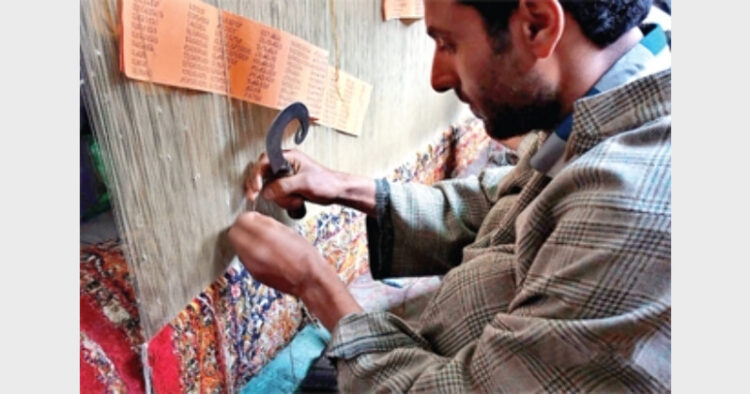When an aggressive real estate growth rips apart the natural beauty of other Himalayan states, Kashmir still looks as if it is in her wedding robe. Unvarnished nature in Kashmir has inspired generations of carpet weavers who have relived the natural beauty of Kashmir on green and white silk base with elaborate details. Gulam Hassan Malla, 40, a state award winner struggles to keep the Kashmiri carpet tradition alive. “The carpet weavers of Kashmir are in real difficulty,” said Gulam Hassan, “We find it difficult to sale our carpets since the market is flooded with cheap mill made carpets which are sold in the name of Kashmiri carpets.”
Many of Hassan’s contemporaries have switched over to other professions due to lack of regular income. “I can’t give up weaving,” said Hassan Malla. His struggle to maintain his family of six including his four school going children has made him age faster. His loom is everything for him. He carefully draws the graph of the subject on a paper. With the help of pattern code he weaves floral motifs, geometric shapes, religious symbols, creepers, animals, birds, flower vase and complicated subject like ‘tree of life’ with 50 different shades of threads. Hasan’s wife prepares the base for painting, puts the thread bundles on the rack, and maintains the loom and does simple designs and polish. When winter grips Kashmir with its icy fingers, this weaving tradition keeps thousands of Kashmiri women busy in their traditional houses of wood and tin.
Hassan hopes for good day to return. “I have made a Ganesh for Prime Minister Narendra Modi,” said Hassan, “he can do something for the artisans of Kashmir.” His eyes show signs of despair when he said my son’s school mates enquired about “My profession and mocked at my son. My son feels I am running against time,” said Hassan. He wants to make a carpet for national award which will take three years to complete with an investment of Rs 3 lakh. He wants to weave nature with 15 types of animals and birds in his new theme “Discovery”. “My son can proudly tell to his friends what I was doing all these years,” said Hassan.
Like Hassan there are a few genuine carpet makers who struggle to keep the craft tradition alive. The market is flooded with mill made cheaper quality carpets. Many show rooms sale duplicate Kashmiri carpets to tourists. Customers fail to identify genuine Kashmiri carpets due to lack of knowledge to identify art object. The Unique Selling Price (USP) of every handicraft is its artistry. “Kashmiri carpet will disappear within five years if such things continue,” said Hassan Malla. The popularity of genuine Kashmiri carpet is very high in European countries, United States of America (USA), Asia and in big Indian cities. Genuine Kashmiri carpet is worth gold as it looks more graceful when it gets older. The artist juxtaposes the motifs in such a manner that it looks as if the figures leap out of the carpets. The artistic composition is unique as every figure in the carpet contributes to express one single message: love, unity and devotion.
Local people feel their carpet hold the family together and they roll out their best carpet to welcome their guest with special Kashmiri kahwa. The motifs woven on carpets are drawn from Hindu, Muslim and Sufi culture which is in fact the true identity of Kashmir. The genuine Kashmiri carpet weaving tradition can generate employment and earn huge foreign currency. But the craft has to be liberated from the grip of the middlemen, traders and the corrupt babus. The gamut of handicraft development schemes have to serve the real purpose. The handicraft development agencies in Kashmir should classify the carpets as genuine, second quality, third quality or mill made. No trader should be allowed to sale mill made carpet for genuine Kashmiri rug. “We need an artisan colony with school, market and hospital,” suggested Hassan. The carpet weavers are the pride of Kashmir and they have immensely contributed to the rich cultural heritage of India. They certainly deserve the basic amenities to remain in this profession.
–Sudhansu R Das
(The writer is a freelance journalist from Hyderabad, recently visited J&K to study Art and Culture)














Comments